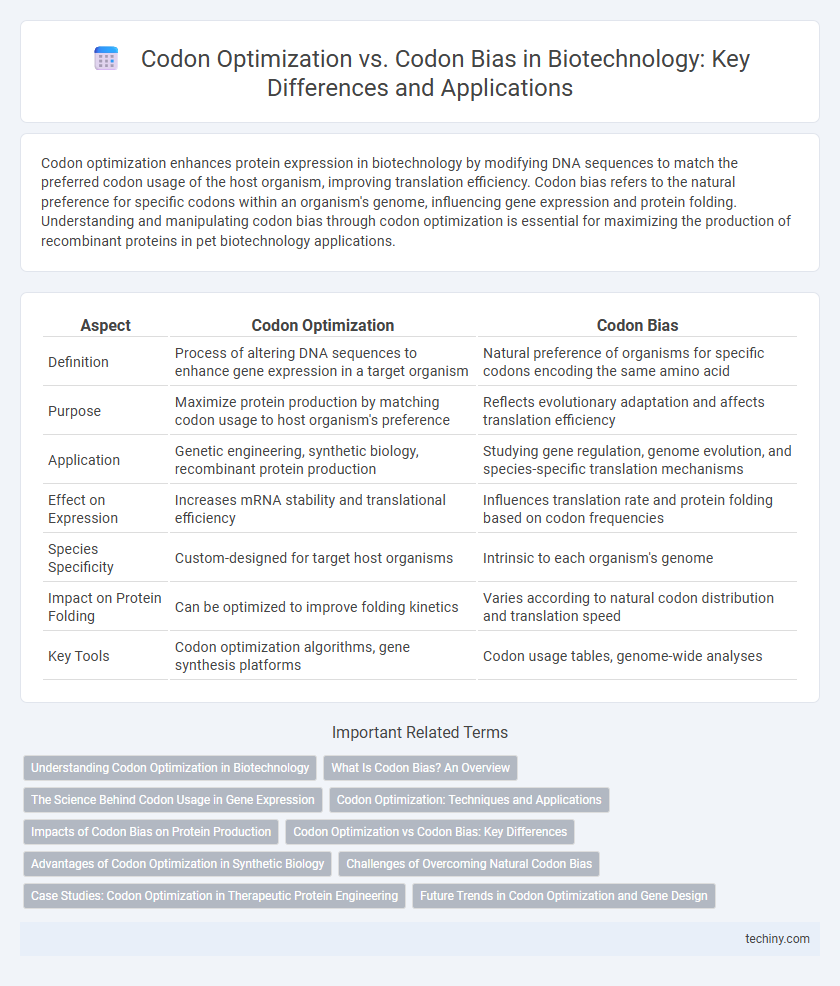Codon optimization enhances protein expression in biotechnology by modifying DNA sequences to match the preferred codon usage of the host organism, improving translation efficiency. Codon bias refers to the natural preference for specific codons within an organism's genome, influencing gene expression and protein folding. Understanding and manipulating codon bias through codon optimization is essential for maximizing the production of recombinant proteins in pet biotechnology applications.
Table of Comparison
| Aspect | Codon Optimization | Codon Bias |
|---|---|---|
| Definition | Process of altering DNA sequences to enhance gene expression in a target organism | Natural preference of organisms for specific codons encoding the same amino acid |
| Purpose | Maximize protein production by matching codon usage to host organism's preference | Reflects evolutionary adaptation and affects translation efficiency |
| Application | Genetic engineering, synthetic biology, recombinant protein production | Studying gene regulation, genome evolution, and species-specific translation mechanisms |
| Effect on Expression | Increases mRNA stability and translational efficiency | Influences translation rate and protein folding based on codon frequencies |
| Species Specificity | Custom-designed for target host organisms | Intrinsic to each organism's genome |
| Impact on Protein Folding | Can be optimized to improve folding kinetics | Varies according to natural codon distribution and translation speed |
| Key Tools | Codon optimization algorithms, gene synthesis platforms | Codon usage tables, genome-wide analyses |
Understanding Codon Optimization in Biotechnology
Codon optimization enhances gene expression by modifying synonymous codons to match the host organism's preferred codon usage, improving translational efficiency and protein yield. Codon bias refers to the non-random usage of synonymous codons in an organism, reflecting tRNA abundance and influencing gene expression levels. Understanding codon optimization allows biotechnologists to tailor genetic constructs for improved performance in heterologous protein production systems.
What Is Codon Bias? An Overview
Codon bias refers to the non-random usage of synonymous codons in the genome, where certain codons are preferred over others despite coding for the same amino acid. This phenomenon influences gene expression efficiency, protein folding, and translation accuracy in different organisms. Understanding codon bias is essential for optimizing heterologous gene expression in biotechnology applications.
The Science Behind Codon Usage in Gene Expression
Codon optimization enhances gene expression by selecting synonymous codons that match the host organism's tRNA abundance, improving translation efficiency and protein yield. Codon bias reflects the non-random usage of certain codons in an organism's genome, influenced by evolutionary pressures and the cellular environment. Understanding the science behind codon usage reveals how manipulating codon sequences can maximize heterologous protein expression in biotechnology applications.
Codon Optimization: Techniques and Applications
Codon optimization enhances gene expression by modifying the DNA sequence to align with the host organism's preferred codon usage without altering the encoded protein. Techniques such as synthetic gene design, software algorithms, and machine learning models enable precise tailoring of codon sequences to improve translation efficiency, mRNA stability, and protein folding. Applications of codon optimization span recombinant protein production, vaccine development, gene therapy, and synthetic biology, significantly increasing yield and functional expression in diverse expression systems.
Impacts of Codon Bias on Protein Production
Codon bias significantly influences protein production by affecting translation efficiency and accuracy, as specific codons are preferentially used in different organisms due to tRNA availability. This bias can lead to variations in protein folding, expression levels, and functional activity, impacting therapeutic protein yields and recombinant expression systems. Understanding codon bias is essential for optimizing gene sequences to enhance protein synthesis in heterologous hosts.
Codon Optimization vs Codon Bias: Key Differences
Codon optimization involves modifying the DNA sequence to use preferred codons for a specific host organism, enhancing gene expression and protein production. Codon bias refers to the natural preference of an organism's translational machinery for certain codons over others, often linked to tRNA abundance. The key difference is that codon optimization is an intentional, designed strategy to improve heterologous gene expression, while codon bias is an inherent genomic characteristic influencing endogenous gene translation efficiency.
Advantages of Codon Optimization in Synthetic Biology
Codon optimization enhances protein expression by tailoring gene sequences to the preferred codon usage of the host organism, leading to increased translation efficiency and accuracy. This approach overcomes natural codon bias limitations that often reduce synthetic gene performance in heterologous systems. Optimized codons improve mRNA stability and folding, crucial for achieving high yields in synthetic biology applications such as recombinant protein production and metabolic pathway engineering.
Challenges of Overcoming Natural Codon Bias
Overcoming natural codon bias presents significant challenges in biotechnology, as organisms preferentially use specific codons that affect protein expression efficiency. Codon optimization must carefully balance altering codon sequences to match host preferences without disrupting mRNA stability, folding, or translation kinetics. Failure to address these complexities can lead to reduced protein yield and functional inefficiency, highlighting the critical need for advanced computational tools and empirical validation in codon design.
Case Studies: Codon Optimization in Therapeutic Protein Engineering
Case studies in therapeutic protein engineering demonstrate that codon optimization significantly enhances protein expression by aligning synthetic gene sequences with host-specific codon bias, improving translational efficiency and protein yield. Research on monoclonal antibody production in mammalian cells reveals that optimized codon usage reduces misfolding and aggregation, crucial for therapeutic efficacy and stability. Comparative analyses across expression systems, such as E. coli and CHO cells, confirm that tailored codon optimization outperforms native sequences by maximizing host cellular machinery compatibility and protein functional quality.
Future Trends in Codon Optimization and Gene Design
Future trends in codon optimization emphasize integrating machine learning algorithms with large genomic datasets to enhance gene expression efficiency and protein yield. Advances in synthetic biology tools will enable precise manipulation of codon bias tailored to specific host organisms, improving translational accuracy and minimizing metabolic burden. Emerging approaches focus on dynamic codon usage adaptation to environmental conditions, optimizing gene designs for biopharmaceutical production and industrial biotechnology applications.
Codon Optimization vs Codon Bias Infographic

 techiny.com
techiny.com